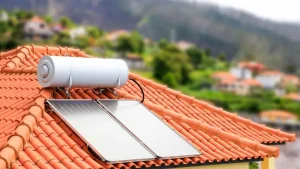As homeowners continue to seek eco-friendly and cost-effective ways to meet their energy needs, active solar water heating systems have emerged as a viable solution. Among these, direct circulation systems are a popular choice for residential homes in regions with mild climates. This article delves into how direct circulation systems work, their suitability, advantages, disadvantages, and alternatives, providing a comprehensive guide for homeowners considering this technology.

How Direct Circulation Systems Work
Direct circulation systems, also known as open-loop systems, use pumps to circulate household water through solar collectors, where it is heated by the sun. The heated water then flows back into the home’s storage tank for immediate or later use. Here’s a step-by-step breakdown of the process:
- Solar Collectors: These are typically installed on the roof or another sunny area. The collectors absorb solar radiation and transfer the heat to the water flowing through them.
- Pump: A pump circulates the water from the storage tank through the collectors and back to the tank. This process is usually controlled by a differential controller, which activates the pump when the temperature in the collectors is higher than the water temperature in the tank.
- Storage Tank: The heated water is stored in a tank, ready for use in household activities like bathing, washing, and cooking.
When Direct Circulation Systems are a Good Solution
Direct circulation systems are particularly effective in regions with mild, non-freezing climates. Here are some scenarios where they are an ideal choice:
- Mild Climates: These systems are best suited for areas where freezing temperatures are rare. Since the system directly circulates household water, freezing can cause significant damage.
- Year-Round Sunshine: Regions with abundant sunshine throughout the year benefit most from direct circulation systems, as the efficiency of solar collectors directly depends on solar availability.
- High Water Heating Demand: Homes with high demand for hot water can see substantial savings on energy bills, as solar water heating can significantly offset traditional energy use.
Advantages of Direct Circulation Systems
- Efficiency: Direct circulation systems are highly efficient because they directly heat the household water, minimizing heat loss associated with heat exchangers in indirect systems.
- Cost-Effective: These systems often have lower initial costs and simpler designs compared to indirect systems, making them a cost-effective option for many homeowners.
- Eco-Friendly: Utilizing solar energy reduces reliance on fossil fuels, decreasing the home’s carbon footprint and promoting sustainability.
- Low Maintenance: With fewer components and simpler operation, direct circulation systems generally require less maintenance compared to more complex systems.
Disadvantages of Direct Circulation Systems
- Vulnerability to Freezing: In regions prone to freezing temperatures, the water in the collectors and pipes can freeze, causing damage and system failure.
- Scaling and Corrosion: The direct circulation of household water through the collectors can lead to scaling and corrosion, especially in areas with hard water.
- Temperature Control: Without proper control mechanisms, there is a risk of overheating the water on very sunny days, potentially leading to safety issues.
Alternatives to Direct Circulation Systems
For homeowners in regions where direct circulation systems may not be suitable, there are several alternatives:
- Indirect Circulation Systems: These systems use a heat exchanger to transfer heat from a non-freezing fluid (such as antifreeze) circulating through the collectors to the household water. This makes them suitable for colder climates.
- Drainback Systems: These systems drain the water from the collectors and pipes when the pump is off, preventing freezing and overheating issues.
- Thermosiphon Systems: Passive systems that rely on natural convection to circulate water. While less efficient than active systems, they have no moving parts and require no pumps.
Conclusion
Direct circulation systems offer an efficient, cost-effective, and eco-friendly solution for solar water heating in residential homes, particularly in mild climates with abundant sunshine. They are straightforward to install and maintain, making them an attractive option for many homeowners. However, their susceptibility to freezing and potential for scaling and corrosion may limit their applicability in certain regions. For those living in areas prone to freezing temperatures, alternatives such as indirect circulation systems or drainback systems may be more appropriate.
In conclusion, direct circulation systems can significantly reduce energy bills and carbon footprints when used in suitable environments. Homeowners should carefully assess their local climate, water quality, and specific needs to determine the best solar water heating solution for their residence. By making an informed choice, they can enjoy the benefits of renewable energy while contributing to a more sustainable future.



